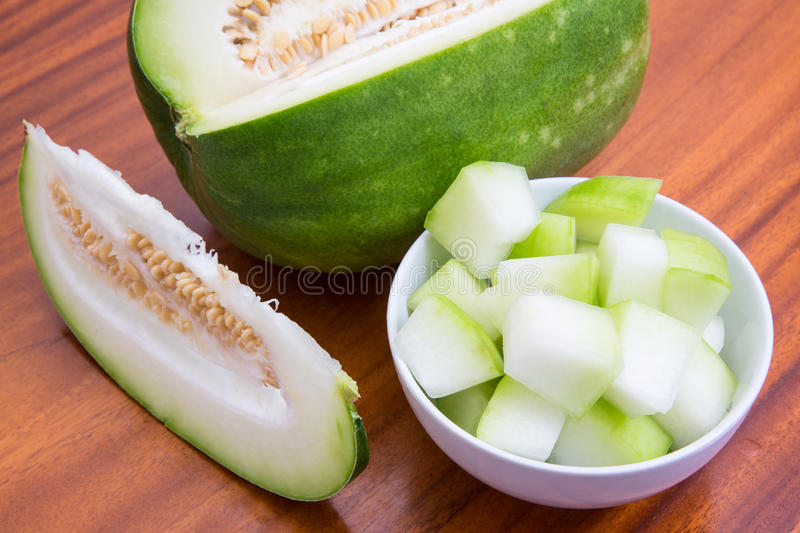WINTER MELON SEEDS PER 10 FOR $4-Add $4 pack/post to the order.
Winter melon is a popular Asian melon used in making delicious soups and Asian dished generally. Roughly the size of a football & bigger.

Winter melon, or ash gourd, is a mild-tasting fruit that’s often used as a vegetable in Asian cuisines—most commonly in Chinese and Indian food.

It’s a popular ingredient in soups, sweets, and beverages. It thrives in warm climates, such as Asia and South Florida. Once picked, the melons are easy to transport, and they store well. They are sold primarily in Asian markets where there is a higher demand.
What Is Winter Melon?

Winter melon, scientifically called Benincasa hispida, is also commonly called ash gourd, wax gourd, white gourd, and winter gourd. It is a member of the gourd family (Cucurbitaceae), commonly referred to as cucurbits, which includes cucumbers, melons, zucchini, pumpkins, and other squash.
:max_bytes(150000):strip_icc():format(webp)/GettyImages-864889724-cd08b2866424480584fb28eda0c0fde3.jpg)
The fruit’s seasonal name likely comes from the fact that, while grown during the summer and autumn, it can be stored for up to three to four months and eaten during the winter. Additionally, immature melon has fine hairs and this fuzziness reminds some people of snow. Once it matures, it loses its hair and gets a waxy coating.

Winter melon can grow to more than a foot in length and weigh more than 40 pounds. It resembles a large watermelon with its oblong shape and dark green, waxy skin, although some are more round in shape.

Unlike a watermelon, the flesh and seeds are white, it’s relatively tasteless, and it cannot be eaten raw. Instead, recipes with winter melon often call for steaming, simmering, or parboiling, but be careful not to overcook it—it can get mushy. You can find winter melon in the produce department already sliced and packaged, which makes them more convenient and economical. How to Cook With Winter Melon
:max_bytes(150000):strip_icc():format(webp)/GettyImages-692520316-9e3fe3200e9d418298a90dc62adea29e.jpg)
The skin and seeds need to be removed when preparing winter melon, including the soft flesh that holds the seeds. Once the harder white flesh is cubed or sliced, it can be steamed, simmered, braised, or parboiled and added to stir-fries. It becomes softer when cooked and, due to its mild flavor, it’s often seasoned with strong spices and herbs.

Best used in soups, winter melon absorbs the flavors of the ingredients it is cooked with. In a popular banquet version of winter melon soup, the fruit serves as a cooking vessel, main ingredient, and the serving dish. The soup is steamed inside a whole winter melon and served that way at the table.
:max_bytes(150000):strip_icc():format(webp)/GettyImages-665519887-e950178ade994c91858d64c9546885f2.jpg)
Winter melon is used in sweets as well and is often diced and candied. It’s also an ingredient for beverages, including sweetened yogurt smoothies in which it is blended with stronger tasting fruits like watermelon. When making winter melon juice, the pureed flesh is strained and then seasoned with lemon juice, pepper, and salt.
:max_bytes(150000):strip_icc():format(webp)/GettyImages-1151415289-a441d6a1c22e42e48faad4eec57684e5.jpg)
What Does It Taste Like?
Mature winter melon has a very mild taste, while the immature fruit is sweet. It’s often compared to the taste of cucumber, with a refreshing, almost grassy flavor. If you’ve eaten the white rind of a watermelon, it’s nearly identical to winter melon. For this reason, watermelon rind is sometimes used as a substitute when winter melon can’t be found.

Winter Melon Recipes
A famous Chinese dish is winter melon soup, where slices of the melon are simmered in a broth with Chinese dried mushrooms, ham, and seasonings. You will find it in recipes for the Chinese wife cake (also called sweetheart cake) and the Indian treat petha, a soft, translucent candy from Agra, and in curries. In the Philippines, it is candied and called kundol. This is used as a filling for bakpia (or hopia), which aresweet bean-filled pastries, similar to moon cake. The winter melon can be substituted in recipes that call for zucchini, and it can be a nice addition to stir-fry noodle dishes.

Henry Sapiecha Any questions or if buying, contact me HERE


